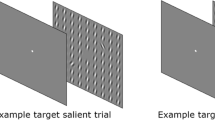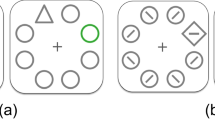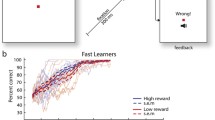Abstract
The control of overt visual attention relies on an interplay of bottom-up and top-down mechanisms. Purely bottom-up models may provide a reasonable account of the looking behaviors of young infants, but they cannot accurately account for attention orienting of adults in many natural behaviors. But how do humans learn to incorporate top-down mechanisms into their control of attention? The phenomenon of gaze following, i.e. the ability to infer where someone else is looking and to orient to the same location, offers an interesting window into this question. We review findings on the emergence of gaze following in human infants and present a computational model of the underlying learning processes. The model exhibits a gradual incorporation of top-down cues in the infant’s attention control. It explains this process in terms of generic reinforcement learning mechanisms. We conclude that reinforcement learning may be a major driving force behind the incorporation of top-down cues into the control of visual attention.
Access this chapter
Tax calculation will be finalised at checkout
Purchases are for personal use only
Preview
Unable to display preview. Download preview PDF.
Similar content being viewed by others
References
Itti, L., Koch, C.: A saliency-based search mechanism for overt and covert shift of visual attention. Vision Research 40, 1489–1506 (2000)
Yarbus, A.L.: Eye movements during perception of complex objects. In: Riggs, L.A. (ed.) Eye Movements and Vision, Ch. VII, pp. 171–196. Plenum Press, New York (1967)
Land, M.F., Mennie, N., Rusted, J.: The roles of vision and eye movements in the control of activities of daily living. Perception 28, 1311–1328 (1999)
Land, M.F., Hayhoe, M.M.: In what ways do eye movements contribute to everyday activities? Vision Research 41, 3559–3565 (2001)
Hayhoe, M., Land, M., Shrivastava, A.: Coordination of eye and hand movements in a normal environment. Invest. Ophthalmol & Vis. Sci. 40, S380 (1999)
Wolfe, J.M.: Visual search. In: Pashler, H. (ed.) Attention, University College London Press, London, UK (1998)
Haith, M.M., Hazan, C., Goodman, G.S.: Expectation and anticipation of dynamic visual events by 3.5-month-old babies. Child Development 59, 467–479 (1988)
Dayan, P., Abbott, L.F.: Theoretical Neuroscience: Computational and Mathematical Modeling of Neural Systems. MIT Press, Cambridge, MA, USA (2001)
Sutton, R.S., Barto, A.G.: Reinforcement Learning. MIT Press, Cambridge, MA (1998)
Scaife, M., Bruner, J.: The capacity for joint visual attention in the infant. Nature 253, 265–266 (1975)
Butterworth, G.E., Cochran, E.: Towards a mechanism of joint visual attention in human infancy. International Journal of Behavioral Development 3, 253–272 (1980)
Butterworth, G.E., Jarrett, N.: What minds have in common is space: Spatial mechanisms serving joint visual attention in infancy. British Journal of Developmental Psychology 9, 55–72 (1991)
Deák, G., Flom, R.A., Pick, A.D.: Effects of Gesture and Target on 12- and 18-Month-Olds’ Joint Visual Attention to Objects in Front of or Behind Them. Developmental Psychology 36, 511–523 (2000)
Brooks, R., Meltzoff, A.N.: The importance of eyes: How infants interpret adult looking behavior. Developmental Psychology 38, 958–966 (2002)
Brooks, R., Meltzoff, A.N.: The development of gaze following and its relation to language. Developmental Science 8, 535–543 (2005)
Meltzoff, A.N., Brooks, R.: Eyes wide shut: The importance of eyes in infant gaze following and understanding of other minds. In: Flom, R., Lee, K., Muir, D. (eds.) Gaze following: Its development and significance, pp. 217–241. Lawrence Erlbaum, Mahwah, NJ (2007)
Mundy, P., Sigman, M., Kasari, C.: A longitudinal study of joint attention and language development in autistic children. Journal of Autism and Developmental Disorders 20, 115–128 (1990)
Treisman, A., Gelade, G.: A feature integration theory of attention. Cognitive Psychology 12, 97–136 (1980)
Brooks, R., Breazeal, C., Marjanovic, M., Scassellati, B., Williamson, M.: The Cog Project: Building a Humanoid Robot. In: Nehaniv, C.L. (ed.) Computation for Metaphors, Analogy, and Agents. LNCS (LNAI), vol. 1562, Springer, Heidelberg (1999)
Kozima, H., Yano, H.: A robot that learns to communicate with human caregivers. In: First International Workshop on Epigenetic Robotics, Lund, Sweden (2001)
Kozima, H.: Infanoid: A babybot that explores the social environment. In: Dautenhahn, K., Bond, A.H., Canamero, L., Edmonds, B. (eds.) Socially Intelligent Agents: Creating Relationships with Computers and Robots, pp. 157–164. Kluwer Academic Publishers, Amsterdam (2002)
Nagai, Y., Hosoda, K., Morita, A., Asada, M.: A constructive model for the development of joint attention. Connection Science 15, 211–229 (2003)
Nagai, Y., Asada, M., Hosoda, K.: Learning for joint attention helped by functional development. Advanced Robotics 20(10), 1165–1181 (2006)
Hoffman, M.W., Grimes, D.B., Shon, A.P., Rao., R.P.N.: A probabilistic model of gaze imitation and shared attention. Neural Networks 19, 299–310 (2006)
Matsuda, G., Omori, T.: Learning of Joint Visual Attention by Reinforcement Learning. In: Altmann, E.M., Cleeremans, A. (eds.) Proceedings of the fourth international conference on cognitive modeling, pp. 157–162. Lawrence Erlbaum Associates, Mahwah, NL (2001)
Triesch, J., Teuscher, C., Deák, G.O., Carlson, E.: Gaze following: why (not) learn it? Developmental Science 9, 125–157 (2006)
Lau, B., Triesch, J.: Learning gaze following in space: a computational model. In: ICDL 2004. 3rd International Conference for Development and Learning, La Jolla, California, USA, pp. 20–22 (October 2004)
Daly, S., Matthews, K., Ribas-Corbera, J.: Visual eccentricity models in face-based video compression. In: IS&SPIE Conference on Human Vision and Electronic Imaging IV, San Jose, California, USA (January 1999)
Stanley, J.C.: Computer simulation of a model of habituation. Nature 261, 146–148 (1976)
Farroni, T., Csibra, G., Simion, F., Johnson, M.H.: Eye contact detection in humans from birth. Proc. Natl. Acad. Sci. USA 99, 9602–9605 (2002)
Li, Z.: Contextual influences in V1 as a basis for pop out and asymmetry in visual search. Proceedings of the National Academy of Sciences 96, 10530–10535 (1999)
Li, Z.: A saliency map in primary visual cortex. Trends in Cognitive Science 6, 9–16 (2002)
von Hofsten, C., Dahlström, E., Fredriksson, Y.: 12-month-old infants’ perception of attention direction in static video images. Infancy 8, 217–231 (2005)
Anstis, S.M., Mayhew, J.W., Morley, T.: The perception of where a face or television ‘portrait’ is looking. American Journal of Psychology 82, 474–489 (1969)
Cline, M.G.: The perception of where a person is looking. American Journal of Psychology 80, 41–50 (1967)
Gibson, J.J., Pick, A.: Perception of another person’s looking behavior. American Journal of Psychology 76, 386–394 (1963)
Jenkins, R., Beaver, J.D., Calder, A.J.: I thought you were looking at me! Direction-specific aftereffects in gaze perception. Psychological Science 17, 506–514 (2006)
Schultz, W., Dayan, P., Montague, P.R.: A neural substrate of prediction and reward. Nature 275, 1593–1599 (1997)
Triesch, J., Jasso, H., Deák, G.O.: Emergency of Mirror Neurons in a Model of Gaze Following. Adaptive Behavior 15, 149–165 (2007)
Fasel, I., Deák, G.O., Triesch, J., Movellan, J.: Combining Embodied Models and Empirical Research for Understanding the Development of Shared Attention. In: ICDL 2002. Proceedings of the International Conference on Development and Learning, Boston, MA, USA (2002)
Johnson, M.H., Dziurawiec, S., Ellis, H.D., Morton, J.: Newborns’ preferential tracking of face-like stimuli and its subsequent decline. Cognition 40, 1–19 (1991)
Valenza, E., Simion, F., Cassia, V.M., Umiltá, C.: Face preference at birth. J. Exp. Psychol. Hum. Percept. Perform 22, 892–903 (1996)
Murray, L., Trevarthen, C.: Emotion regulation of the interactions between two-month-olds and their mothers. In: Field, T., Fox, N. (eds.) Social perception in infants, pp. 89–111. Ablex, Norwood, NJ (1985)
Roberts, S., Pashler, H.: How persuasive is a good fit? A comment on theory testing. Psychological Review 107, 358–367 (2000)
Jasso, H., Triesch, J., Deák, G.O.: A reinforcement learning model explains the development of gaze following. In: ICCM 2006. Proceedings of the 7th International Conference on Cognitive Modeling, Trieste, Italy (2006)
Jasso, H., Triesch, J.: Using eye direction cues for gaze following - a developmental model. In: ICDL 2006. Proceedings of the 5th International Conference on Development and Learning, Bloomington, IN, USA (2006)
Jasso, H.: A reinforcement learning model of gaze following. Unpublished Ph.D. dissertation. University of California, San Diego (2007)
Adrien, J.L., Lenoir, P., Martineau, J., Perrot, A., Hameury, L., Larmande, C., Sauvage, D.: Blind ratings of early symptoms of autism based upon family home movies. Journal of the American Academy of Child and Adolescent Psychiatry 32, 617–626 (1993)
Hutt, C., Ounsted, C.: The biological significance of gaze aversion with particular reference to the syndrome of infantile autism. Behavioral Science 11(5), 346–356 (1966)
Itti, L., Koch, C.: Computational modelling of visual attention. Nature Reviews Neuroscience 2, 194–203 (2001)
Zhaoping, L.: A saliency map in primary visual cortex. Trends in Cognitive Sciences 6, 9–16 (2002)
Author information
Authors and Affiliations
Editor information
Editors and Affiliations
Rights and permissions
Copyright information
© 2007 Springer-Verlag Berlin Heidelberg
About this paper
Cite this paper
Jasso, H., Triesch, J. (2007). Learning to Attend — From Bottom-Up to Top-Down. In: Paletta, L., Rome, E. (eds) Attention in Cognitive Systems. Theories and Systems from an Interdisciplinary Viewpoint. WAPCV 2007. Lecture Notes in Computer Science(), vol 4840. Springer, Berlin, Heidelberg. https://doi.org/10.1007/978-3-540-77343-6_7
Download citation
DOI: https://doi.org/10.1007/978-3-540-77343-6_7
Publisher Name: Springer, Berlin, Heidelberg
Print ISBN: 978-3-540-77342-9
Online ISBN: 978-3-540-77343-6
eBook Packages: Computer ScienceComputer Science (R0)




